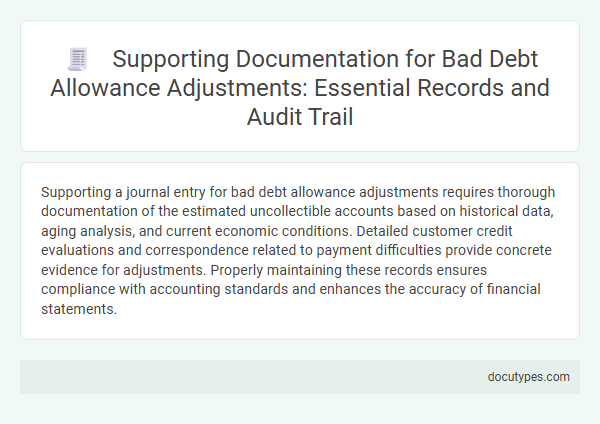Supporting a journal entry for bad debt allowance adjustments requires thorough documentation of the estimated uncollectible accounts based on historical data, aging analysis, and current economic conditions. Detailed customer credit evaluations and correspondence related to payment difficulties provide concrete evidence for adjustments. Properly maintaining these records ensures compliance with accounting standards and enhances the accuracy of financial statements.
Introduction to Bad Debt Allowance Adjustments
What supports the journal entry for bad debt allowance adjustments? The allowance for doubtful accounts is supported by historical data on uncollectible receivables and updated based on recent collection trends. Your company's financial statements rely on these adjustments to accurately reflect potential credit losses and maintain compliance with accounting standards.
Importance of Supporting Documentation in Bad Debt Accounting
Supporting documentation is crucial for the accuracy and reliability of journal entries in bad debt allowance adjustments. Proper documentation ensures compliance with accounting standards and aids in accurate financial reporting.
- Customer Correspondence - Communication records such as emails or letters confirm efforts to collect outstanding debts and justify allowance adjustments.
- Ageing Reports - Detailed ageing schedules categorize receivables based on delinquency, providing a basis for estimating bad debt allowances.
- Approval Records - Authorization from management or accounting supervisors validates the legitimacy of the adjustments made to bad debt accounts.
Essential Financial Records for Bad Debt Allowance
| Essential Financial Records | Description |
|---|---|
| Accounts Receivable Ledger | Detailed record of all outstanding customer balances used to identify doubtful accounts requiring bad debt allowance adjustments. |
| Customer Payment History | Historical data on customer payments and defaults helps assess the likelihood of collectability and supports allowance estimates. |
| Ageing Schedule | Breakdown of receivables by time outstanding to determine the risk level of each account and justify allowance amounts. |
| Previous Bad Debt Write-offs | Records of past uncollectible accounts inform trends and validate the basis for current period adjustments to bad debt allowance. |
| Management Estimates and Policies | Documented guidelines and judgment used by management to estimate the allowance ensure consistency and compliance with accounting standards. |
| Financial Statements | Supporting disclosures in balance sheets and notes confirm the adjustment is reflected accurately in overall financial reporting. |
Role of Aging Reports in Bad Debt Assessment
The primary support for journal entries related to bad debt allowance adjustments comes from detailed aging reports, which categorize receivables based on the length of time they have been outstanding. These reports enable precise assessment of collectibility risk, allowing businesses to estimate bad debt more accurately by identifying overdue accounts that are more likely to default. Your financial records rely on these structured insights to justify adjustments, ensuring compliance with accounting standards and improving the accuracy of financial statements.
Verification Through Customer Communication Records
Verification through customer communication records is crucial for supporting journal entries related to bad debt allowance adjustments. These records provide concrete evidence of interactions, payment negotiations, and disputes that justify adjustments in the allowance.
Customer communication logs such as emails, call transcripts, and payment reminders help validate the estimated uncollectible amounts recorded in financial statements. These documents serve as proof that the company has made reasonable efforts to collect outstanding debts. Auditors and accountants rely on this data to ensure the accuracy and legitimacy of bad debt allowances before finalizing journal entries.
Utilizing Invoice and Payment Histories
The journal entry for bad debt allowance adjustments is supported primarily by detailed invoice and payment histories. These records provide essential data to accurately estimate the amount of receivables that may become uncollectible.
Using your invoice and payment histories helps identify patterns of late or missed payments, which inform the adjustment of the allowance for doubtful accounts. This method ensures that the financial statements reflect a realistic expectation of cash flow from receivables.
Internal Approval Memos and Authorization Evidence
Internal approval memos and authorization evidence are critical for supporting journal entries related to bad debt allowance adjustments. These documents ensure compliance with accounting policies and provide a clear audit trail for financial controls.
- Internal Approval Memos - Document management's review and consent for adjusting bad debt allowances, reflecting evaluation of receivables risk.
- Authorization Evidence - Includes signed forms or electronic approvals verifying that adjustments comply with company policies and regulatory standards.
- Audit Trail - Maintains detailed records linking the adjustment to authorized personnel for transparency and accountability in financial reporting.
Proper documentation supports accuracy and integrity in financial statements, aligning with best practices in finance management.
Collection Efforts and Correspondence Documentation
Accurate journal entry adjustments for bad debt allowance rely heavily on thorough documentation of collection efforts and correspondence. Your financial records must reflect these detailed records to justify adjustments and maintain audit compliance.
- Collection Efforts - Detailed logs of phone calls, payment reminders, and follow-ups provide concrete evidence supporting the likelihood of debt recovery or write-off decisions.
- Correspondence Documentation - Copies of letters, emails, and customer responses demonstrate communication attempts and support the rationale for adjusting bad debt allowances.
- Audit Trail - Maintaining a clear trail of documented interactions ensures transparency and substantiates the journal entry during internal or external audits.
Maintaining a Robust Audit Trail for Adjustments
Maintaining a robust audit trail for bad debt allowance adjustments is essential to ensure transparency and accuracy in financial reporting. Detailed documentation such as aging reports, customer communication records, and management approvals support the journal entries made for these adjustments. This comprehensive trail enables auditors to verify the legitimacy and rationale behind the allowance changes, strengthening internal controls and compliance with accounting standards.
What Supports the Journal Entry for Bad Debt Allowance Adjustments? Infographic

